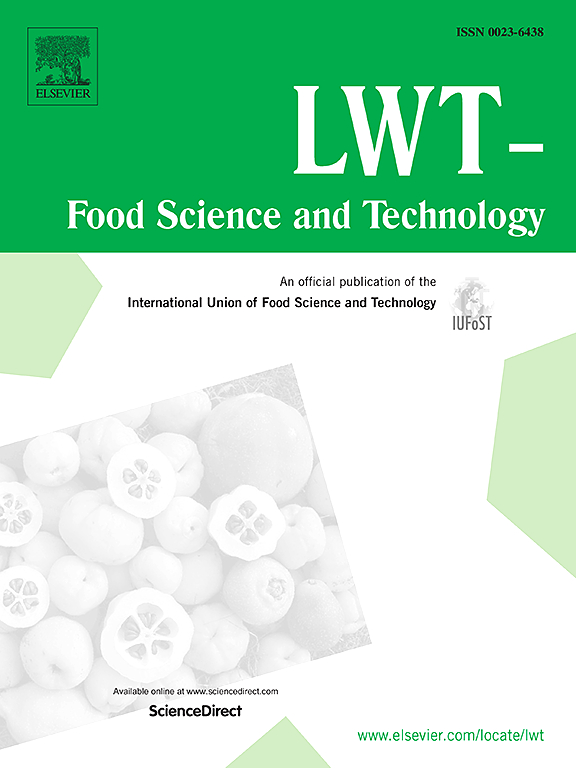Optimization of ultrasound-assisted extraction of astaxanthin from black tiger shrimp (Penaeus monodon) shells using deep eutectic solvent and ethanol as a co-solvent
IF 6
1区 农林科学
Q1 FOOD SCIENCE & TECHNOLOGY
引用次数: 0
Abstract
The study aimed to enhance the extraction of astaxanthin (ASX) from black tiger shrimp shells by combining Deep eutectic solvent (DES) and ultrasound-assisted extraction (UADE). The DES used in the research consisted of choline chloride (Ch) and lactic acid (LA) in a 1:2 M ratio with 20% water. Response surface methodology (RSM) utilizing a Box-Behnken design (BBD) was employed to optimize the UADE conditions, considering ultrasound power (200–400 W), ethanol concentration in the DES (5–65 %), and extraction time (5–45 min). The optimal UADE parameters identified by BBD were 330 W ultrasound power, 35% ethanol content, and 33 min of extraction, resulting in the highest ASX content of 47.42 μg/g, closely matching the predicted value of 48.65 μg/g. Scanning electron microscopy (SEM) and Fourier transform infrared spectroscopy (FTIR) analysis revealed structural alterations in samples treated with DES-based UAE, setting it apart from soxhlet extraction, maceration, and ethanol-based DES extraction. The outcomes indicated that UADE outperformed traditional extraction methods like soxhlet extraction, maceration, and ultrasound-assisted ethanol extraction (UAET) regarding ASX yield and antioxidant activity, while also needing shorter extraction durations. These results underscore UADE as a productive and eco-friendly approach for extracting ASX from shrimp shells.
使用深共晶溶剂和乙醇作为辅助溶剂从黑虎虾(Penaeus monodon)虾壳中优化超声辅助提取虾青素的方法
该研究旨在通过将深层共晶溶剂(DES)和超声辅助萃取(UADE)相结合,提高从黑虎虾壳中提取虾青素(ASX)的效率。研究中使用的DES由氯化胆碱(Ch)和乳酸(LA)以1:2 M的比例与20%的水组成。采用箱-贝肯设计(BBD)响应面方法(RSM)对 UADE 条件进行了优化,考虑了超声功率(200-400 W)、DES 中的乙醇浓度(5-65 %)和萃取时间(5-45 分钟)。BBD 确定的最佳 UADE 参数为超声功率 330 W、乙醇含量 35%、萃取时间 33 分钟,结果 ASX 含量最高,为 47.42 μg/g,与预测值 48.65 μg/g 非常接近。扫描电子显微镜(SEM)和傅立叶变换红外光谱(FTIR)分析表明,用基于 DES 的 UAE 处理的样品结构发生了变化,使其有别于索氏提取、浸渍和基于乙醇的 DES 提取。研究结果表明,UADE 在 ASX 产量和抗氧化活性方面优于传统的提取方法,如索氏提取、浸渍和超声辅助乙醇提取(UAET),同时所需的提取时间也更短。这些结果表明,UADE 是一种高效、环保的从虾壳中提取 ASX 的方法。
本文章由计算机程序翻译,如有差异,请以英文原文为准。
求助全文
约1分钟内获得全文
求助全文
来源期刊

LWT - Food Science and Technology
工程技术-食品科技
CiteScore
11.80
自引率
6.70%
发文量
1724
审稿时长
65 days
期刊介绍:
LWT - Food Science and Technology is an international journal that publishes innovative papers in the fields of food chemistry, biochemistry, microbiology, technology and nutrition. The work described should be innovative either in the approach or in the methods used. The significance of the results either for the science community or for the food industry must also be specified. Contributions written in English are welcomed in the form of review articles, short reviews, research papers, and research notes. Papers featuring animal trials and cell cultures are outside the scope of the journal and will not be considered for publication.
 求助内容:
求助内容: 应助结果提醒方式:
应助结果提醒方式:


